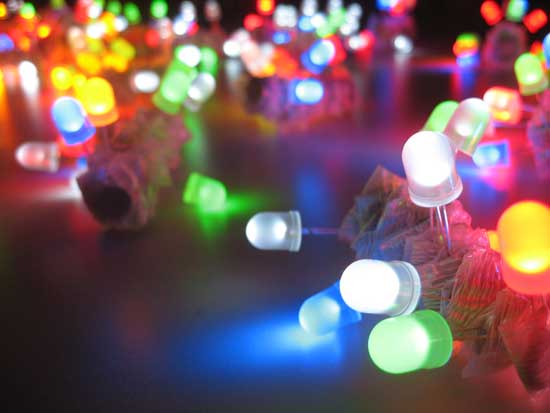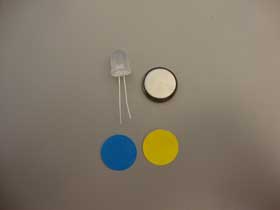Physics on Your Christmas Tree: Lighting up with LEDs
In the season of lights, make your own glowing creations.


What you Need
- LED (10mm diffused LED works best can be purchased from radioshack – red LED, blue LED, white LED)
- 3V lithium ion battery
- Circle label stickers (like you’d find at a garage sale)
- disk magnets
What to Do
- Take the LED and put each side of the 3V lithium ion battery between the two legs of the LED. The long leg should be on the positive side of the battery and the shorter leg should be on the negative side of the battery. If it doesn’t light up, try flipping the battery.
- Put one circle label sticker on each side of the battery, securing the LED in place.
- Put a magnet on the outside of the sticker on the battery (it doesn’t matter what side it is on).
- Stick to a metal object like your refrigerator.
 |
 |
 |
 |
 |
 |
 |
What’s Going On?
LEDs are not just fun, but they are extremely useful and energy efficient. They can be found adorning the Christmas trees in families’ houses, hanging like glowing icicles from the rooftops of homes, or shining from behind the green, yellow and red of stop lights.
LEDs have become more common for a number of reasons. The little lights require far less energy than incandescent light bulbs and they actually emit the color of light that you see, unlike the incandescent bulbs that used filters to create light. LEDs are special. If step one was not done correctly, the LED doesn’t work. This is because LED stands for Light Emitting Diode, which is basically a diode that emits, or gives off, light. Diodes only allow electricity to flow in one direction. The long leg is the negative end of the LED and it needs to be connected to the positive side of the battery in order for the electrons to be able to travel from the battery into the LED. The shorter end of the LED should be connected to the negative side of the battery which then allows the electrons to flow from the LED back into the battery and then be able to continue around again. When electrons flow in a circle like this they create a circuit which allows for the LED to continue to be powered. If a break in the circuit occurs, the LED will no longer light up.
LEDs are also special because inside the LED there is a semiconductor, which varies depending on the color of light that the LED emits. The semiconductor gallium arsenide is used to make red LEDs and some green LEDs are made with gallium arsenide phosphide. These semiconductors change what energy level photon, light particle, gets released; therefore determining what color the LED will emit.
Next time the tree tops glisten, consider the science that makes the season bright.
Try This!
- Try doing the experiment with a 9V battery instead of the 3V battery. Does it work? What happens?
- Try using other colors of LEDs.
- Try stringing the LEDs contraptions together to make a string of Christmas lights.
More Information











